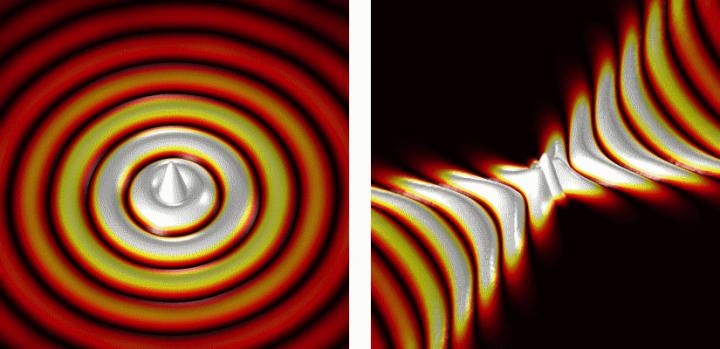Feb 25 2018
Optical waves that travel away from a point source characteristically exhibit circular, or convex, wavefronts. “Like waves on a water surface when a stone is dropped,” explained Peining Li, first author of the study, who is EU Marie Sklodowska-Curie fellow at nanoGUNE.
The circular propagation originates due to the fact that the medium through which light waves propagate is essentially isotropic (i.e. uniform in all directions) and homogeneous.
 This is an illustration of waves propagating away from a point-like source. Left: Regular wave propagation. Right: Wave propagation on a hyperbolic metasurface. (Image credit: P. Li, CIC nanoGUNE)
This is an illustration of waves propagating away from a point-like source. Left: Regular wave propagation. Right: Wave propagation on a hyperbolic metasurface. (Image credit: P. Li, CIC nanoGUNE)
Researchers had hitherto theoretically estimated that surfaces structured in a specific manner can overturn the wavefronts while it travels along them. “On such surfaces, called hyberbolic metasurfaces, the waves emitted from a point source propagate only in certain directions and with open (concave) wavefronts,” elucidated Javier Alfaro, co-author of the study, who is a Ph.D. student at nanoGUNE. These atypical waves are termed hyperbolic surface polaritons. As they travel only in specific directions and with wavelengths that are considerably smaller than wavelengths of light in standard waveguides or free space, they could assist in miniaturizing optical devices for signal processing and sensing.
At present, the team has created such a metasurface for infrared light, which is based on boron nitride (a graphene-like 2D material) and was chosen due to its potential to regulate infrared light on very small length scales, which can be used for creating miniaturized chemical sensors or for regulating heat in nanoscale optoelectronic devices. In contrast, the team was successful in observing the concave wavefronts, which could not be observed thus far, by using a specialized optical microscope.
It is very difficult to develop hyperbolic metasurfaces because a highly accurate structuring on the nanometer scale is mandatory. Ph.D. student Irene Dolado from nanoGUNE, and Saül Vélez, a former postdoctoral researcher at nanoGUNE who works at ETH Zürich at present, overcame this difficulty by adopting electron beam lithography as well as etching of thin flakes of high-quality boron nitride offered by Kansas State University. “After several optimization steps, we achieved the required precision and obtained grating structures with gap sizes as small as 25 nm,” stated Dolado. “The same fabrication methods can also be applied to other materials, which could pave the way to realize artificial metasurface structures with custom-made optical properties,” added Saül Vélez.
In order to observe the propagation of the waves along the metasurface, the team adopted an advanced infrared nanoimaging method that was developed by the nanoptics group at nanoGUNE. At first, the team placed an infrared gold nanorod on the metasurface.
“It plays the role of a stone dropped into water,” stated Peining Li. Incident infrared light is concentrated into a tiny spot by the nanorod, thereby launching waves that subsequently travel along the metasurface. The team imaged the waves by using a so-called scattering-type scanning near-field microscope, or s-SNOM. “It was amazing to see the images. They indeed showed the concave curvature of the wavefronts that were propagating away from the gold nanorod, exactly as predicted by theory,” stated Rainer Hillenbrand, Ikerbasque Professor at nanoGUNE, who headed the study.
The outcomes indicate that nanostructured 2D materials can be used as an innovative platform for hyberbolic metasurface devices and circuits, and further indicate the way near-field microscopy can be adopted to unearth striking optical phenomena in anisotropic materials and to evidence new metasurface design concepts.